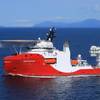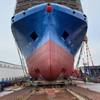The comment period for vessel owner/operators affected by the Automated Identification System (AIS) ends July 31. AIS is a shipboard broadcast system that acts like a continuous and autonomous transponder, operating in the VHF maritime band. The system allows ships to easily track, identify and exchange pertinent navigation information from one another or ashore; for collision avoidance, security and VTS reporting.
“This schedule is of particular importance to fishing vessels that travel to and from Alaska to Seattle,” said Capt. Richard Preston, chief of the Seventeenth Coast Guard District’s Operational Plans and Policy Division in Juneau. “Fishing vessels sixty-five-feet or larger that operate in Prince William Sound will also have to have a properly working AIS installed.” The cost for the equipment and installation could cost about $9,300 for each unit.
These following commercial domestic vessels, while transiting areas detailed below, must have an installed, operational AIS that complies with the standards for such devices adopted internationally and approved by the Coast Guard.
Each self-propelled vessel of 65 feet or more in length, engaged in commercial service (including fishing);
Each towing vessel of 26 feet or more in length and more than 600 horsepower;
Each vessel of 100-gross tons or more carrying one or more passengers for hire; and
Each passenger vessel certificated to carry 50 or more passengers for hire.
These vessels must comply according to the following schedule when using the listed Vessel Traffic Systems or Vessel Movement Reporting Systems:
VTS St. Mary’s River, MI; no later than Dec. 31, 2003;
VTS Berwick Bay, LA; VMRS Los Angeles/Long Beach; VTS Lower Mississippi River; VTS Port Arthur, TX; VTS Prince William Sound, AK; no later than July 1, 2004;
VTS Houston-Galveston; VTS New York; VTS Puget Sound, WA; VTS San Francisco; no later than Dec. 31, 2004;
VTS Berwick Bay, LA; VMRS Los Angeles/Long Beach; VTS Lower Mississippi River; VTS Port Arthur, TX; VTS Prince William Sound, AK; no later than July 1, 2004;
VTS Houston-Galveston; VTS New York; VTS Puget Sound, WA; VTS San Francisco; no later than Dec. 31, 2004.
“There is also an obvious safety advantage to having this technology,” said Preston. “A vessel's position will be seen by other vessels, and by ground base stations (when within coverage areas). Potentially providing much more timely positional information for search and rescue efforts.”
More information, including schedules for internationally bound vessels, can be found at www.navcen.uscg.gov/enav/ais/default.htm
Subscribe for
Maritime Reporter E-News
Maritime Reporter E-News is the maritime industry's largest circulation and most authoritative ENews Service, delivered to your Email five times per week










